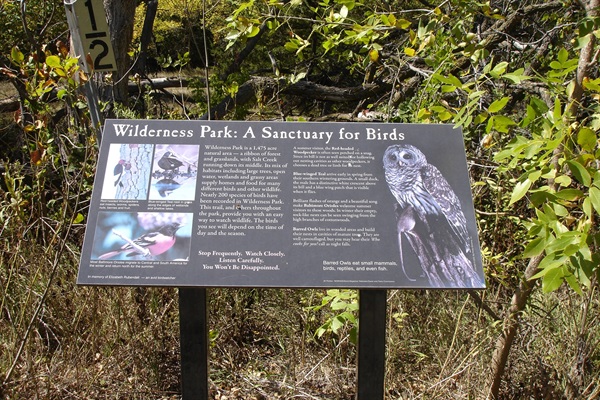Wilderness Park is a haven for migratory and resident birds!
The park’s many habitat niches provide food and safety year-round for hundreds of species of birds. But they can be difficult to spot if they are tiny like a warbler or hidden in dense vegetation like a towhee. Here are a few species of birds that you can find within the park with tips on where you might find them singing, eating, or nesting.
The high woodland canopy is a favorite spot to watch for migratory birds in spring and summer. Colorful warbler species are found here including American Redstarts and Tennessee Warblers, gleaning small insects from the under sides of elm and hackberry leaves. Watch for the striking blue of the Indigo Bunting high above the creek, singing its song of paired notes dripping downward in doubles. Red-eyed and Yellow-throated Vireos also perch in the canopy, matching the leaves with their olive and green backs.

Thickets in the understory and along the forest edge provide cover and fruit for many avian species all year round. Mimics like Brown Thrashers and Gray Catbirds can be found skulking, singing songs that sound like several other birds at once. Dogwoods, plums, and honeysuckles are also favorite spots to listen for the “Drink Your Tea” song of the Eastern Towhee and the bubbling babble of the House Wren. Red-tailed Hawk can be seen perching along edges of grassy meadows. . Open grasses provide feeding areas for several sparrow species including Clay-colored, White-throated, and Lincoln’s sparrows.
The open water and banks of Salt Creek are home to many wetland species including Great Blue Heron (which nest together in a rookery high in the canopy in the park) as well as Wood Ducks, Blue-winged Teal, and Song Sparrows.
The woodlands are home to many birds year-round. Many woodpeckers, including Downy, Hairy, and Red-bellied Woodpecker, live and feed year-round in old trees in the park. The alarm call of “chick-a-dee-dee-dee” can be heard on almost any walk as Black-capped Chickadees spot danger and White-breasted Nuthatches “meep” in reply.